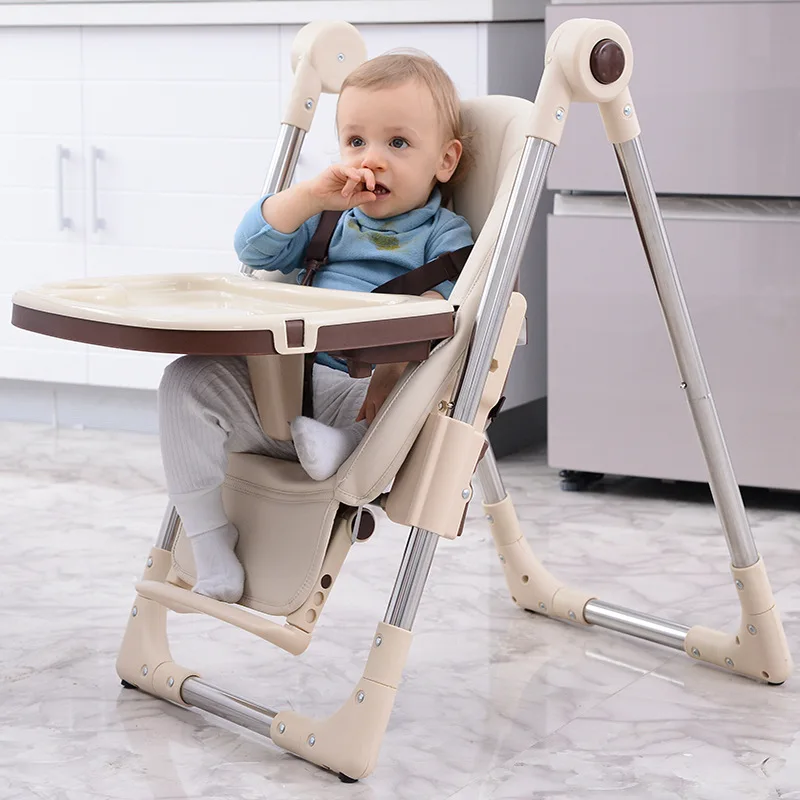Blank baby feeding chart
A Newborn Feeding Chart That Works (With Printable!)
What's in this post...
Inside you’ll find all you need to know to put into a newborn feeding chart and then have a printable one for yourself! Whether or not you are interested in sleep training, this will get you started on a great solid routine.
I gave birth to my firstborn in a hospital in Aberdeenshire, Scotland.
With a midwife whom I’d never met.
It all happened so fast and no one thought I was actually near 10 cm because they hadn’t checked dilation since I wasn’t in much pain. Must not be close, they assumed.
But really I’m a redhead and my pain signals are all jacked up so then it was go time before we knew it.
“But I don’t even have the paperwork ready…” she said in a sort of sweet and confused voice.
“IT’LL WAIT!” I yelled.
Fast forward a few days…
Fast forward a few days and I was ready to start tracking my baby’s feeds. I couldn’t remember which side she had fed from or if she was feeding enough and I felt stressed.
I wanted to write it down and keep it in her nursery. So I used a pen and a little notepad and over the next few weeks kept diligent track to make sure things seemed okay.
They were!
Read: The ultimate newborn napping, feeding, and sleeping schedule
Newborn Feeding Chart
Use this simple printable chart to track your feeds to make sure baby is fed, your supply is up, and everyone is well.
Basic Feeding Tips For The Early Weeks
(Psst… you can scroll down and get your free downloadable newborn feeding chart).
Here are some basic rules of thumb when it comes to feeding newborns. Talk to your pediatrician or nursing consultant if you have any issues, but for most babies these principles will help you have a calm, contented baby.
Read: 8 reasons you’ve got a fussy whiny little one
Focus On Filling Baby Up
Newborns are sleepy.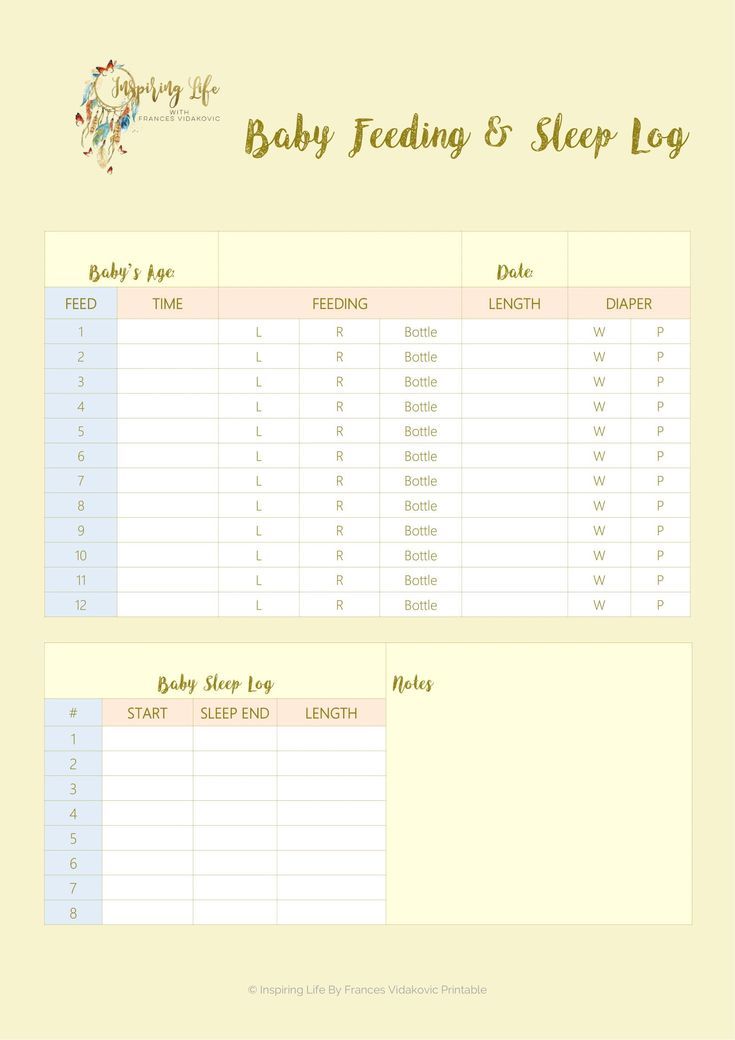 They want to feed a bit then nod off. This is not a good idea for a few reasons, listed below.
They want to feed a bit then nod off. This is not a good idea for a few reasons, listed below.
To keep track of whether or not your baby is taking full feeds, scroll down and get your free newborn feeding chart so you can keep track.
- Babies do not get the breast milk most rich in fat and calories (the hind milk) because if they nurse for a short period they’re only getting the fore milk (less density which means less filling).
- Also, they will not go into a deep sleep (which takes around 20 minutes) and then when they transition through sleep cycles (around 45 minutes or so after they’ve gone to sleep) they’ll wake up out of hunger.
- You will be feeding baby every hour all day long.
Related Reads:
- What To Do When Baby Is Feeding Every Hour (& Not Sleeping!)
- Feeding Baby Through One Year
Newborn Settling Guide
Tried-and-true *hands on* newborn settling strategies that even the most fussy (or wide-awake-sleep-refusing) newborns cannot resist!
Learn More
Feed Unswaddled By Day And Swaddled By Night
We want our babies to know the difference between night and day so they’ll have their wake times in the day and sleepy time at night.
This means that we create certain associations with being awake and other associations with sleep. One of those is the swaddle. You should swaddle from Day One because this will decrease the likelihood your baby “fights the swaddle.”
I had 5 babies and none fought the swaddle because we did it from Day One and there simply wasn’t an option.
Babies who are not swaddled will wake frequently or nap lighter since the startle reflex (moro reflex) will cause their arms to rise up and “startle.”
If they aren’t in a deep sleep cycle this might be enough to wake them.
During the day unswaddle them to feed so you’re communicating wake time. At night, unswaddle the bottom of their swaddle (the swaddles perfect for this shown below) to change their diaper, then reswaddle them and feed swaddled. This means baby will essentially sleep through the feed. Voila!
Read: How to clear up daytime and nighttime confusion in babies
Bring Baby To You, Don’t Lean Towards Baby
Those midwives in Scotland had it going on.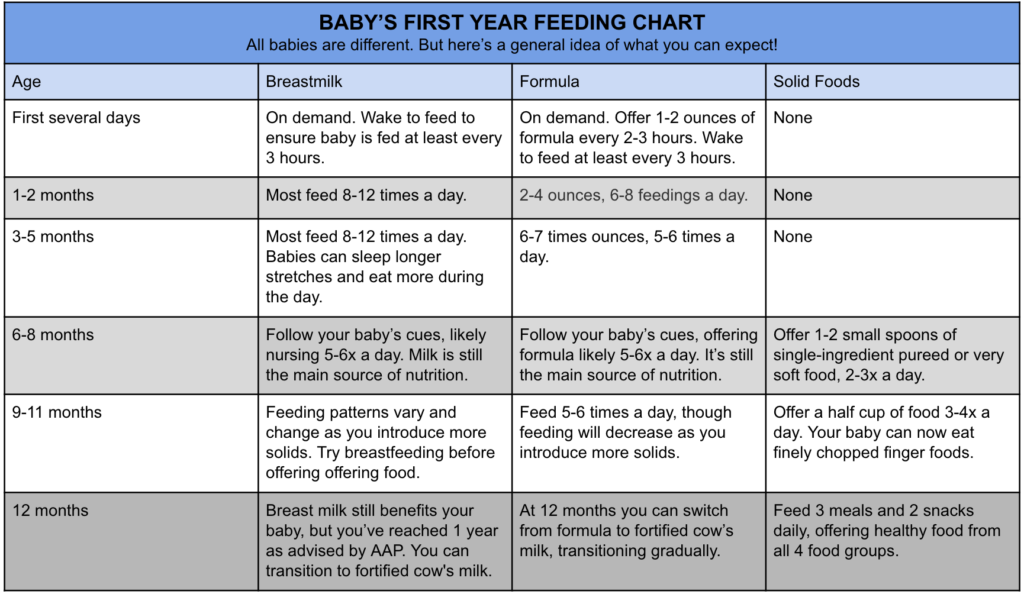 Not only did they give you all the logistics while you were in the hospital, they visited you for a few weeks AT HOME during the postpartum period.
Not only did they give you all the logistics while you were in the hospital, they visited you for a few weeks AT HOME during the postpartum period.
You could ask them absolutely anything about anything and they helped make it all work. One thing they gave me in my welcome packet was a DVD on how to get baby to latch properly.
With 5 babies I have had 0 issues with latching on and I’m telling you this works.
Instead of leaning down onto baby, position the breast and the baby’s head so that you push the baby onto your breast.
This means your bringing baby where the milk is, not trying to bring the milk down to baby. And, it means this will make for a better latch.
Related Reads:
- The Difference Between Midwives And Doctors
- How To Get Your Newborn To Sleep Well From Day One
Newborn Feeding Chart
Use this simple printable chart to track your feeds to make sure baby is fed, your supply is up, and everyone is well.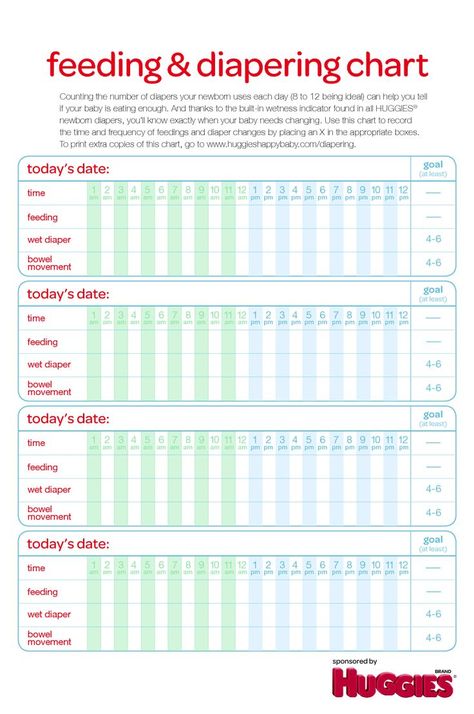
Example Daily Rhythm
Newborns have tiny tummies. You’ll be feeding baby around the clock for weeks at a time. However, by giving full feeds and keeping baby awake during feeds (which can be a feat) you’ll be able to increase the time between feeds providing baby with more restorative naps.
Initially you want to aim for feeding baby every 2.5 to 3 hours. So you may feed at 6 am, 8:30 am, 11:00 am, then 2:00 p.m.
The only reasons baby should feed less than 2.5 hours apart are these:
- Baby is not feeding enough at each feed (not getting calorie rich hind milk or enough ounces of formula)
- They are going through a growth spurt.
- You are cluster feeding in late afternoon early evening on purpose.
Read: The Easy Peasy Newborn Routine That Makes For Happy Babies
A Printable Chart That Works Like A Charm
I’ve created a newborn feeding chart below where you can record what times your baby is feeding and use that to find a good rhythm for you and your baby.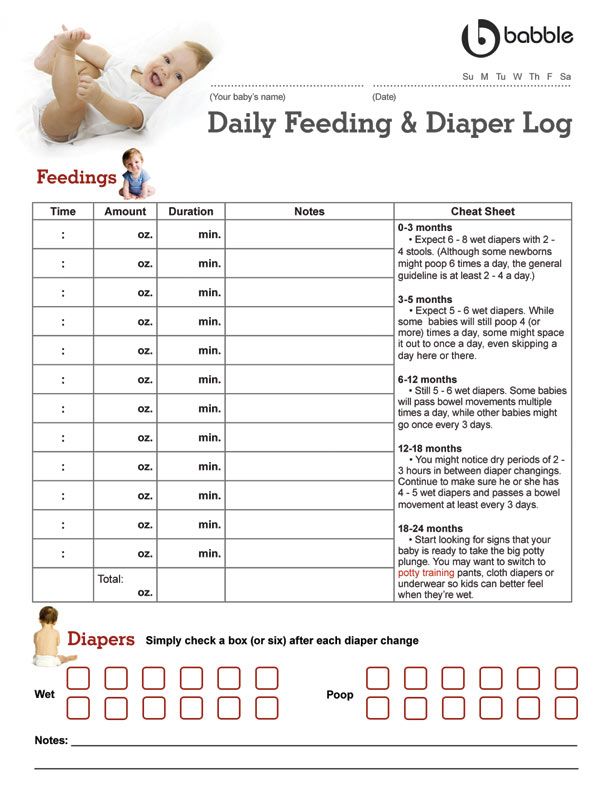
Read: The Dreamfeed: The Why, The How, & When To Stop
Is baby sleeping okay?
Baby bedtime can begin to feel like an actual nightmare.
Moms just want baby to sleep well. You just want to have some peace and quiet after a long day of momming and yet you are spending so much time trying to comfort an exhausted baby and wondering where it all went to pot.
Because moms with babies are busy (and tired) I created a set of nitty gritty baby sleep checklists that get straight to the point.
- Things to look for if your baby is sick.
- Habits to check if your baby won’t sleep at night.
- What to do if your baby won’t go back to sleep at night.
- And so much more!
It’s not usually some major problem that’s causing baby sleep issues, it’s usually something small. Use these checklists and get some clarity today.
Read: Cocooning a Newborn & 7 Reasons Why it Can Be Good For The Family
Newborn Feeding Chart
Use this simple printable chart to track your feeds to make sure baby is fed, your supply is up, and everyone is well.
Sources:
- The importance of schedules and routines
- Routines minimize chaos which promotes resilience and regulation
- Routines indicators of predictable family life contributing to childhood development
Family Routines Reboot
Take our 3 day challenge to create life-giving family, child, and self-care routines.
Learn More
::
Printable Baby Schedule Chart To Help Baby Settle Into Routine
The first few days and weeks with a newborn are a blur of feeding, sleeping and crying. While your newborns needs may be sporadic, it won’t be long before patterns develop. Once those patterns begin to form, you can help your babe settle into a daily routine. A printable baby schedule chart can help you identify patterns and figure out a routine that works for the whole family.
Sponsored post by Mirum Shopper. All opinions are my own.
Printable Baby Schedule Chart
Although routines change as baby grows, having a general idea of when your baby will need to eat or sleep helps the whole family feel more settled.
Now that my daughter is three months old, I can look back and clearly see when patterns in her eating and sleeping started to develop. Those patterns slowly became routine for us so that I have a pretty good idea of what to expect on an average day. Of course, anything (like my current head cold) can throw a monkey wrench in our routine, but generally I know when she will sleep and when she will be hungry.
It is important to note that routines are not established overnight, and it may take several weeks to see a pattern emerge. But once you identify a pattern, you can encourage that pattern or encourage tweaks to that pattern to create a routine that works for the whole family.
Download the Printable Baby Schedule Chart here.
Parent’s Choice Formula
As routines settle into place it becomes easier to recognize your baby’s needs. Keeping feeding schedules routine is just as important as routine sleep.
Whether your baby is formula fed or you supplement with formula, it is important to know you are giving your baby formula that is easy to digest and has been well tolerated by millions of babies. Parent’s Choice helps parents save up to $600 a year over alternative formulas and is nutritionally comparable to more expensive national brand infant formulas, including Enfamil®, Similac®, and Gerber®.
Parent’s Choice helps parents save up to $600 a year over alternative formulas and is nutritionally comparable to more expensive national brand infant formulas, including Enfamil®, Similac®, and Gerber®.
Clinically proven to be as well tolerated by infants as national brand formulas, Parent’s Choice is, of course, compliant with FDA nutritional standards and the recommendations of the AAP – the American Academy of Pediatrics. And it is clinically proven to support growth and development.
You can find Parent’s Choice at Walmart and the formula options include:
- Parent’s Choice® Premium Powder Infant Formula
- Value Size 35oz
- Makes 65, 4 oz. bottles
- Clinically proven to support growth and development
- Parent’s Choice® Advantage Tub Powder Stage 2 Formula
- Value Size 35oz
- Suitable for babies 612 months
- Parent’s Choice® Sensitivity Canned Powder Infant Formula
- Value Size 33.
 2oz
2oz - Makes 59, 4oz bottles
- For fussiness & gas
- Value Size 33.
- Parent’s Choice® Gentle Infant Formula with Iron
- Value Size 33.2oz
- Makes 60, 4 oz. bottles
- For fussiness, gas and crying
DIY, Printables free printable, printable
Reader Interactions
Daily routine for a child under 1 year old
Daily routine is a system for distributing periods of sleep and wakefulness, meals, hygiene and health procedures, activities and independent human activities throughout the day.
Compliance with a rational daily routine corresponding to the age characteristics of the child contributes to his healthy growth and development. Getting used to performing various types of activities at the same time, the child is prepared for the upcoming type of activity at every moment of time, which ensures their easier and faster implementation. Compliance with the correct daily routine provides a good mood for the child and maintains a keen interest in the study of the world around him, contributing to his normal motor and psychoverbal development.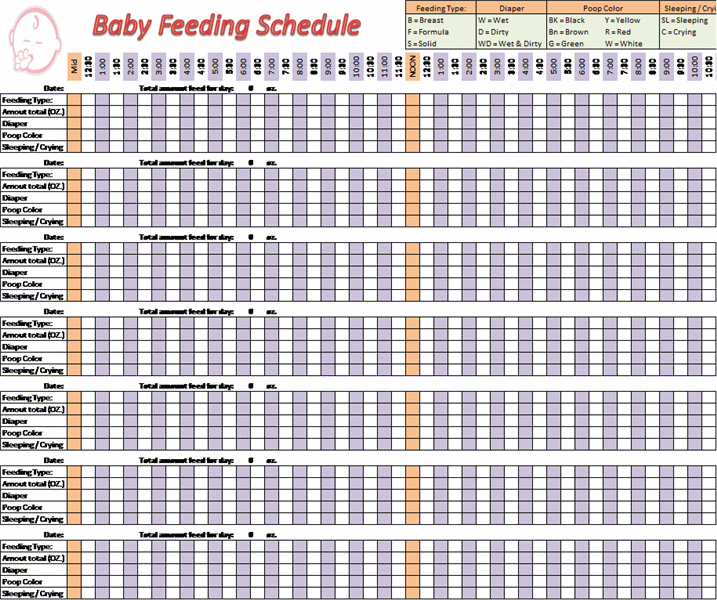
The child's daily routine includes the following obligatory elements: diet, time spent outdoors during the day, frequency and duration of sleep, mandatory classes to develop skills in accordance with age, free time.
In the first months after birth, a healthy newborn baby sleeps for most of the day, since all external stimuli are very strong for the nervous system of a child, accustomed to a cozy intrauterine environment, and cause its rapid exhaustion. As the child grows older, the duration of sleep gradually decreases and the time of wakefulness increases.
| Age | Daytime sleep mode | Night sleep | Wake mode |
| From birth to 2 months | 6 x 2.5 hours | 6 hours | During feeding |
| 2-4 months | 5 times 2-2.5 hours | 6.5 hours | 4 x 1.5 hours |
| 4-6 months | 4-5 times for 2 hours | 7 hours | 4 times 2 hours |
| 6-9 months | 3-4 times for 1.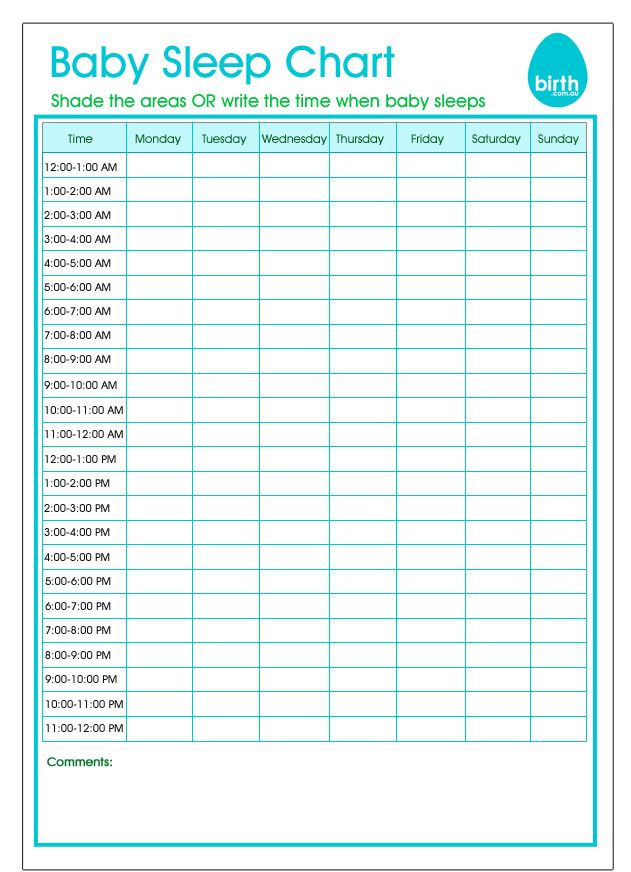 5-2 hours 5-2 hours | 8 hours | 4 x 2.5 hours |
| 9-12 months | 2 x 1.5-2 hours | 9-10 hours | 4 times for 3-4 hours |
Closely related to the sleep-wake mode is the feeding mode of the baby. The sleep of a child in the first months of life is very sensitive and is easily disturbed under the influence of various extraneous stimuli, including hunger.
| Age | Mode | Example |
| From birth to 2 months | 7-8 times, every 3 hours | 6,9,12,15,18,21,24 (no night feeding) |
| From 2 to 6 months | 6-7 times, every 3.5 hours | 6, 9.30, 13, 16.30, 20, 23.30 (without night feeding) 6, 9.30, 13, 16.30, 20, 23.30, 03 (with night feeding) |
| From 7-12 months | 5 times, every 4 hours | 6,10,14,18,22 |
A child's stay in the fresh air is essential in the daily routine.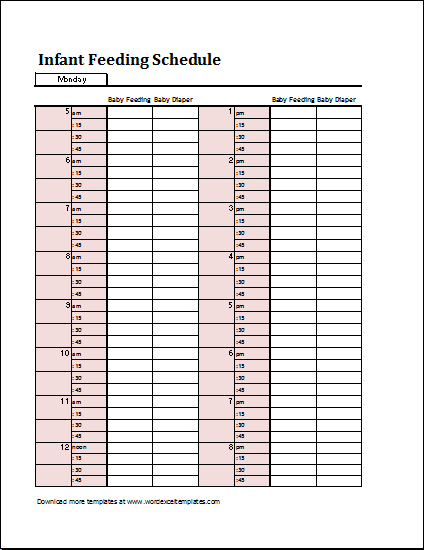 The total duration of stay in the open air for children under 1 year of age should be at least 5-6 hours a day. Fresh air has a calming effect on the baby, improves metabolic processes, and increases the body's defenses. In the summer, all games and activities should be held outdoors; in the cold and transitional seasons, two one-time walks of 1.5-2 hours are provided.
The total duration of stay in the open air for children under 1 year of age should be at least 5-6 hours a day. Fresh air has a calming effect on the baby, improves metabolic processes, and increases the body's defenses. In the summer, all games and activities should be held outdoors; in the cold and transitional seasons, two one-time walks of 1.5-2 hours are provided.
Fresh air also has a beneficial effect on sleep. By acting on the skin and mucous membranes of the nose and upper respiratory tract, it provides a faster fall asleep of the child and a higher quality of sleep. Sleeping outside can replace a walk, especially during the cold season.
The child's daily routine is generally individual, but ideally, one should strive to ensure that the child eats after waking up, and then stays awake until the next sleep. A well-slept baby eats with appetite and then calmly and actively plays or engages, and tired of games, easily goes to sleep.
When your baby is awake, try to keep him active and cheerful.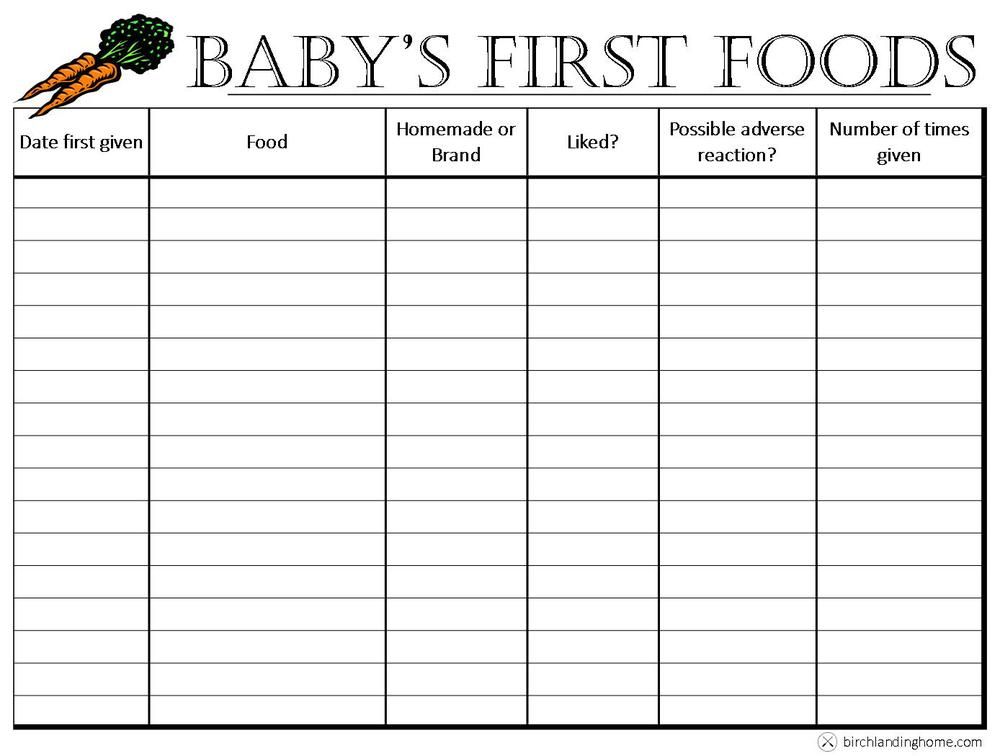 It is necessary to dress the child in loose clothing that does not hinder movement, provide access to toys appropriate for his age, and most importantly, actively participate in games and activities with the baby as a whole family.
It is necessary to dress the child in loose clothing that does not hinder movement, provide access to toys appropriate for his age, and most importantly, actively participate in games and activities with the baby as a whole family.
Author - Physiotherapist - DMITRIENKO T.G.
newborn sleep and feeding schedule
02/26/2019
11
Your baby is almost 5 weeks old and do you remember how the first month was filled with new emotions, doubts and discoveries for you and your baby? But now you better understand your monthly baby and strive to organize a comfortable daily routine for your child. “What is important to consider at this age? How many hours of sleep and wake is enough for a child? How to properly organize the approximate regimen and feeding of a newborn this month? Frequently asked questions by new parents. Let's explore them together!
Baby's daily routine
1 month
In the first month of life, sleep is extremely important for the development of children, their growth and mood. Therefore, it is necessary to pay special attention to organizing the rest of the crumbs.
Therefore, it is necessary to pay special attention to organizing the rest of the crumbs.
The baby sleeps approximately 17-20 hours a day. At the same time, some children of this age sleep more, others less.
Usually night sleep is 7-10 hours with awakenings for feeding, and daytime sleep is about 8-9 hours. With this mode, you will notice that the baby sleeps 4-6 times a day. It is important to remember that a newborn's daytime sleep can be both short (20-40 minutes) and long (up to 3 hours).
This is due to the fact that the brain of a newborn is not yet physiologically mature, the biological clock is not formed, so the child does not have any clear regimen. It turns out that you will not be able to achieve one schedule daily yet. Also, leaving at night can change and be quite late. You will also notice that the baby during the rest gurgles, moves and does not seem to be actually sleeping. The fact is that now the child sleeps mainly in the fast phase, so now children's sleep is quite restless.
Waking time - is the second important point that should be taken into account when forming the routine of a monthly baby. On average, the baby should be awake for up to 60 minutes. Focus on the time that the child slept in the previous daytime sleep - as much as possible he can hold out in the waking state. This will also help organize the baby's routine this month.
Avoid overwork and keep track of the time of activity between sleeps. Do not be afraid to soothe a newborn baby by any means.
What can you do to make your baby sleep better:
- Swaddle your baby so that he calms down faster and does not wake himself up with his arms and legs.
-
Organize sleep in your stroller. Babies tend to sleep longer outdoors. How long it takes to walk depends on the time of year. In summer it is possible up to 2-3 hours in a row, in winter - depending on weather conditions.
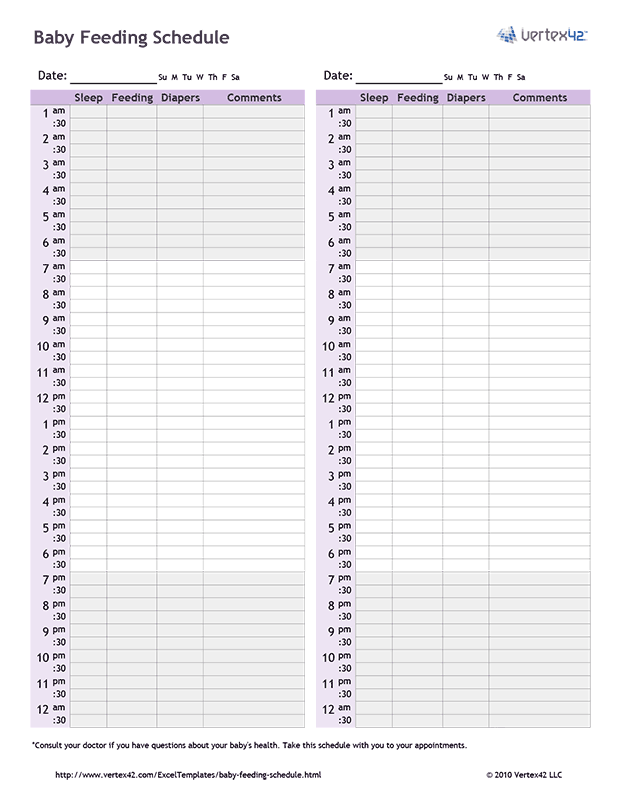 If it's too cold outside, the best way out is to put the child on the balcony.
If it's too cold outside, the best way out is to put the child on the balcony. -
If the baby has difficulty falling asleep in the evening, dim the lights in advance, turn on white noise.
- Use a sling or chaise longue if the baby is completely capricious.
- Start bedtime when you see the first signs of fatigue in the child - this is exactly the time when he wants to sleep.
- Remember that a change of bed can wake up your baby. If you decide to transfer a sleeping baby from your arms to the crib, do it 20 minutes after falling asleep, when the baby is fast asleep.
- Bathe your baby before bed. Soon, bathing for him will be a signal to end the day and prepare for bed.
- Give your baby a pacifier if he can't sleep. Just remember that it is better to start using a pacifier when breastfeeding after lactation is established.
- Use a weak night light during night feeding.
Causes of poor sleep in a 1 month old baby can be:
1. Physical discomfort. In the evening, the baby may begin an attack of colic, which lasts from 2 to 6 hours. Support the baby in every possible way on such days - by 6 weeks relief will come. Also remember that the baby takes over your state. A calm mother is a calm baby. Therefore, try not to forget about your rest too and do not worry if the regime is violated.
Physical discomfort. In the evening, the baby may begin an attack of colic, which lasts from 2 to 6 hours. Support the baby in every possible way on such days - by 6 weeks relief will come. Also remember that the baby takes over your state. A calm mother is a calm baby. Therefore, try not to forget about your rest too and do not worry if the regime is violated.
2. Confusion of day and night. Due to the not yet formed circadian rhythms, a 1-month-old baby may sleep more during the day than at night. But already by 1.5 months, the baby will begin to sleep at night for up to 3-5 hours in a row. Take your child out to bright light during the day and dim the lights at night. So the baby's body will quickly adjust the internal clock. Try to start the morning early so that the child understands that the day has come. Carrying out hygiene procedures will become for him an association with the morning.
The table shows the sleep norms of a baby in the first month of life:
Baby's feeding schedule
1 month
A newborn baby basically eats every 2-3 hours, regardless of the time of day. Therefore, do not worry if the child often wakes up at night now.
Therefore, do not worry if the child often wakes up at night now.
IV babies eat less frequently because formula takes longer to digest than breast milk.
Modern pediatricians advise in the first weeks of a child's life on breastfeeding to organize meals on demand in order to establish lactation. Night feeding also occurs on demand.
Gradually, you will learn to understand when the baby is hungry and asks for breasts. Also during this period, breasts are a way for children to satisfy the sucking reflex, calm down and relax.
When breastfeeding, the baby does not need water or other fluids for the first 6 months.
After the first month, the intervals between feedings will gradually increase. This will allow you to establish a more flexible mode when breastfeeding.
After a month, the break between feedings will increase, and you can move on to establishing a flexible regimen.

